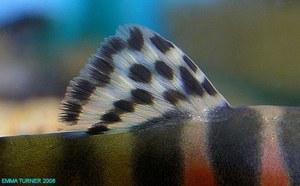Schistura cf. balteata
Summary

Scientific name: Schistura cf. balteata
Exact species is yet to be determined.
Common name: Sumo Loach
Synonyms: None
Distribution: Vietnam/Thailand.
Collectors report different details in populations from Kanchanaburi and Ranchaburi. Fish with spotted dorsals and dark bands under dorsal (as pictured) are the Ranchaburi population. Another supplier has sourced similar fish from Vietnam.
Sexual Dimorphism: Unknown. Mature males are said to have 'puffed cheeks' when viewed head-on. Mature females likely to have a much rounder abdomen.
Maximum size: Probably around 10cm (4").
Similar to: Schistura balteata, Schistura sp. aff paucifasciata.
Care: As with other species of Schistura, this is a territorial species that should be provided with numerous hiding places amongst bogwood, plants, rocky caves and cobbles. When keeping more than one specimen it is important to create visual barriers between each hiding place. Although quite a shy species, it can be nippy towards it's own kind (or other Nemacheiline loaches) when defending its territory.
Ideally, these loaches should be provided with brook/hillstream aquarium conditions incorporating a high flow rate and well oxygenated water - please see Hillstream Loaches: The Specialists at Life in the Fast Lane for a more detailed explanation.
 Dither fish such as some species of Danio, Rasbora, Barb, and Tetra make good candidates for tankmates. Will not bother 'sucker-belly' type hillstream loach species.
Dither fish such as some species of Danio, Rasbora, Barb, and Tetra make good candidates for tankmates. Will not bother 'sucker-belly' type hillstream loach species.
Feeding: Will eagerly accept most aquarium fare offered - sinking catfish pellets, flake, frozen foods such as mosquito larvae, brineshrimp, Daphnia etc.
Water parameters: pH: 6-7.5, Hardness: soft and slightly acidic is best. Max dh: 12.
Temperature: 73ºF to 79ºF (23-26°C)
Breeding: Unknown
Notes
 This recently imported species (mid 2006) caused quite a sensation because of its bright colors and strikingly marked dorsal fin.
This recently imported species (mid 2006) caused quite a sensation because of its bright colors and strikingly marked dorsal fin.
The yellow and pink-colored fish occur in the same locations at the same time. It is not known if the differences represent any sexual dimorphism.
These fish are quite snappy with one another and require lots of hiding places.
Photo Gallery
Click to view all images of this species! |
Document Actions

